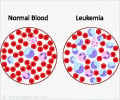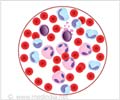Study identifies new targeted molecular therapy to prevent the progression of aggressive pediatric mixed lineage leukemia.

- Mixed lineage leukemia (MLL) is an aggressive form of leukemia that primarily strikes newborns and infants.
- It is caused by an errant chromosome 11 on MLL gene, which has two versions- chimeric and wild type.
- The MLL caused by the wild-type version had extremely low levels of a protein.
- The newly identified compound helps stabilize MLL protein that impedes MLL leukemia cell growth and halts its progress
TOP INSIGHT
The new targeted molecular therapy helps in stabilization of mixed lineage leukemia (MLL) protein and halts the progress of aggressive MLL leukemia.
Mixed Lineage Leukemia
Mixed lineage leukemia (MLL) is an aggressive form of leukemia that primarily strikes newborns and infants. Annually, 300 cases are seen across the U.S.
Mixed lineage leukemia is caused when an errant chromosome 11 on the MLL gene breaks and attaches to other chromosomes such as chromosome 19.
This mutation produces a protein that drives the pathogenesis of leukemia.
Current Focus
The researchers investigated the wild-type version and discovered that in pediatric leukemia produced by the wild-type MLL gene, individual cells had extremely low levels of a protein.
The researchers then suggested increasing the levels of the wild-type MLL protein, so that it would help displace the mutated version that drives cancer. This could lead to a cure for MLL.
They then identified a compound that stabilized the wild-type MLL and interfered with the MLL leukemia cell proliferation.
To test its effectiveness of the new compound, researchers grew mixed lineage leukemia cells in a culture and transplanted them into mice.
They injected the therapeutic compound into the mice and found that the wild-type MLL returned to healthy levels, and the leukemic cells were not able to grow as rapidly.
Conclusion
Better compounds are now being synthesized and researchers hope to launch a Phase I trial to test these compounds in Chicago.
Researchers are hopeful about this breakthrough and are in the process of pushing their findings into clinic for the treatment of childhood leukemia.
The paper is published in the journal Cell.
Reference
- Ali Shilatifard et al. Therapeutic Targeting of MLL Degradation Pathways in MLL-Rearranged Leukemia. Cell; (2017) doi.org/10.1016/j.cell.2016.12.011
Source-Medindia
 MEDINDIA
MEDINDIA




 Email
Email








